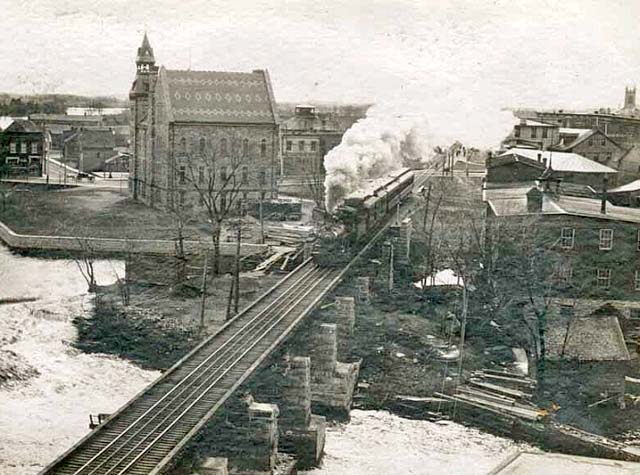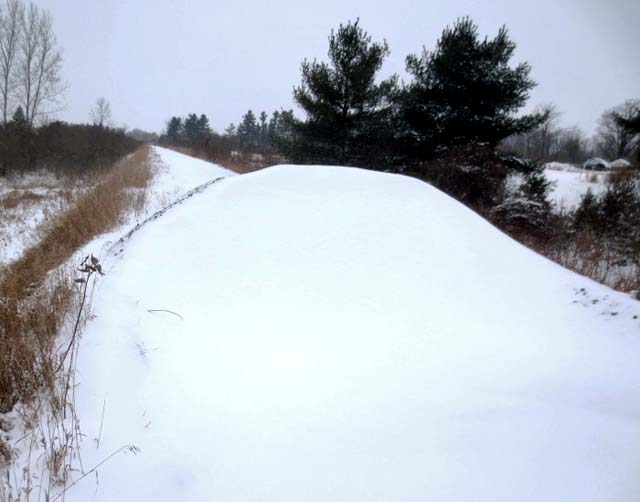|
A Canadian Pacific train crosses the bridge over the Mississippi River at Almonte - Date unknown Anonymous Photographer -
Michael Dunn Digital Archive.
15 December 2014
Berms Block Railbed and Why Isn't a Donation of the Corridor Possible?
Smiths Falls Ontario - In the absence of hard facts about the current negotiations, there are at least some hard berms on the rail bed
to focus on while a discussion of certain terms, and the research of various issues, continues on the potential purchase of the Canadian Pacific rail corridor
from Smiths Falls to Mattawa.
Seen from an angle of corporate prosperity, and considered in the light of the company's gifting history, the challenge of purchasing the CP rail bed looks
more like an opportunity for the donation of the land.
CP is enjoying economic success and has a history of giving away abandoned rail corridors.
Founded in 1881, CP became one of the largest and most powerful companies in Canada, a position it held as late as 1975 according to tables published that year
in Canadian Business.
It then ranked 4th behind Ford, Imperial Oil, and General Motors.
Investors in CP have been well rewarded over the past five years.
A March 2014 analysis pointed out that the company's shares were up more than 250 percent since the market's big decline in 2008-2009.
Results were particularly impressive over the past two years.
CP's third quarter performance in 2014 was another success story, as reported by the Financial Post in October.
According to CP's CEO, Hunter Harrison, the corporate team "delivered another quarter of impressive results".
He expressed confidence that the company was "on track to finish the year with CP's strongest quarter to date."
The company had $400 million of net income in the third quarter.
At the end of Friday's trading on the Toronto Stock Exchange, Canadian Pacific Railway closed up $2.84 or 1.41 percent to $204.15.
While CP shares lost 6.75 percent over the week, they gained 27.08 percent over the past year.
Also noted was that this security outperformed the S&P TSX by 22.76 percent during the last year.
CP's policy of land gifts captured national attention in 1999 when the company donated 38 sections of former rail lines in six provinces for the Trans-Canada
Trail.
The donation in Ontario at the time was a 117.5 kilometres / 73 mile line from Owen Sound to Orangeville.
On the British Columbia mainland, the CP donations of the Columbia & Western and Kettle Valley lines were made to the Province for a non-motorized
cross-country rail trail experience.
On Vancouver Island in 2006, CP donated track to the Island Corridor Foundation, a partnership that included 14 municipalities, 5 regional districts, and 12
First Nations territories.
It was noted at the time that CP received a $243 million tax credit for the donation.
Research has shown that early Canadian railway companies, most notably CP, received large direct subsidies in the form of cash payments, as well as indirect
subsidies in the form of land grants, rail construction, cheap credit, monopoly privileges, cartelizing regulations, and cost reimbursement.
A study by Professor L.J. Mercer, published in 1972 by the Business History Review, found that, out of the railways investigated, CP benefited most from
government aid.
Including cash subsidies and land grants, he determined that public funded support to CP amounted to 55.6 percent of investment in present value terms at the
time of the study.
Over the period 1927-1991, according to the Fraser Institute, direct subsidy payments to the Canadian rail sector totaled almost $12 billion (1991 dollars),
with $11 billion accounted for in the period 1967-1991.
This didn't include subsidy payments made under the Western Grain Transportation Act, and direct federal assistance to Canadian National.
The massive subsidies included rail passenger movement, branch lines, and eastern grain movement.
The cancellation of explicit transportation subsidies resulted from changes in federal regulations.
Earlier this year, Canadian Business reported that over the past decade CP paid just $138 million in cash taxes, or just 2 percent of its pre-tax
profits.
It was noted that this amount was significantly less than the low 19 percent paid by CN Rail, our other major railroad.
The potential purchasers of the abandoned rail line are carrying a significant debt load.
Years of provincial downloading of services and programs continue to affect municipal budgets.
Although Lanark County reduced its debt by $6.5 million in the 2014 budget, its debt repayments were still in the magnitude of $1 million up to
31 July 2014.
Renfrew County's debt charges for 2013 were $1.1 million.
The Township of Papineau-Cameron paid $41,142 in debt charges for 2013.
The partner municipalities are currently discussing the potential purchase of about 302 kilometres / 187.7 miles of abandoned rail bed from Smiths Falls to
Mattawa with a corporation that:
- was given the publicly owned land;
- received massive subsidies for years and years which were funded by the public purse;
- has a giving history of donating abandoned rail corridors;
- is familiar with receiving a tax credit for donated land;
- in the past five years has seen its shares rise by more than 250 percent, with particularly impressive results over the past two years;
- pays amazingly low taxes;
- with a net profit of $400 million in the third quarter, is looking to finish the year with its strongest quarter to date.
It's a matter of perspective looking over the top of a snow covered berm on an abandoned rail bed.
Neil Carleton.
A snow covered gravel berm on the abandoned rail bed - Date unknown Anonymous Photographer.
|



